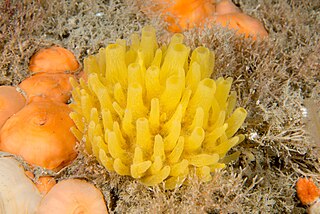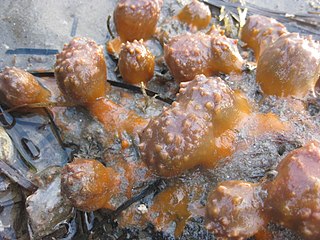
Geodia is a genus of sea sponge belonging to the family Geodiidae. It is the type genus of its taxonomic family.

Polymastia is a genus of sea sponges containing about 30 species. These are small to large encrusting or dome-shaped sponges with a smooth surface having many teat-shaped projections (papillae). In areas of strong wave action, this genus does not grow the teat structures, but instead grows in a corrugated form.

Chondrocladia is a genus of carnivorous demosponges of the family Cladorhizidae. Neocladia was long considered a junior synonym, but has recently become accepted as a distinct genus.
Stelletta is a genus of sea sponges belonging to the family Ancorinidae.

Mycalidae is a family of marine demosponges.

Myxilla is a genus of demosponge belonging to the family Myxillidae. These sponges usually form encrustations on rock surfaces.

Aaptos is a genus of sea sponges in the family Suberitidae.

Xestospongia is a genus of sponges in the family Petrosiidae. It contains the following species:

Crella is a genus of marine demosponges in the family Crellidae.

Craniella is a genus of marine sponges in the family Tetillidae.

Euplectellidae is a family of glass sponges (Hexactinellids) belonging to the order Lyssacinosa, first represented in the Ordovician fossil record, substantially older than molecular estimates of the clade's age.

Discodermia is a genus of deep-water sea sponge.
Amorphinopsis is a genus of sea sponges belonging to the family Halichondriidae.
Ciocalypta is a genus of sea sponges belonging to the family Halichondriidae.

Antho is a genus of sponges belonging to the family Microcionidae. The genus has a cosmopolitan distribution and is known from virtually all parts of the global ocean. There are 62 species in five subgenera.

Acarnus is a genus of sponges belonging to the family Acarnidae. The genus has almost cosmopolitan distribution.

Phakellia is a genus of sponges belonging to the family Bubaridae. The genus has a cosmopolitan distribution.
Stelligera is a genus of sponges belonging to the family Stelligeridae.
Hamacantha is a genus of sponges in the family Hamacanthidae. This species in this genus differ from those in the other genera in this family through the presence of diancistras, distinctive microscleres. These are thought to aid in framing the skeleton by joining monactine megascleres. This genus contains 30 species in three subgenera.
Tetilla is a genus of demosponges in the family Tetillidae. It is widely distributed. They are mainly found in deeper habitats.














